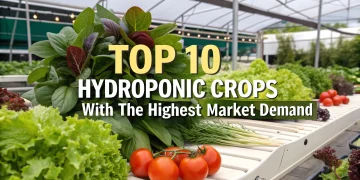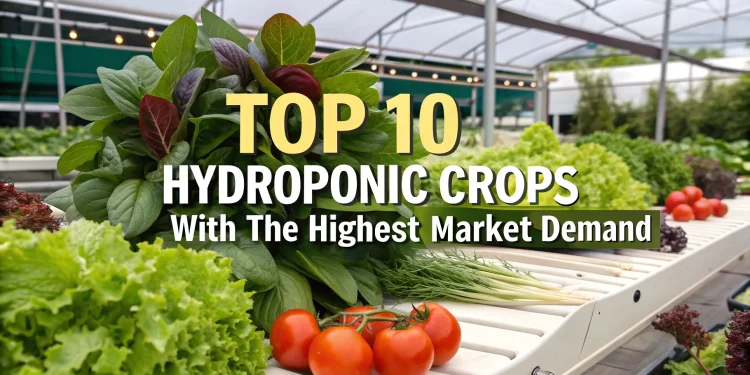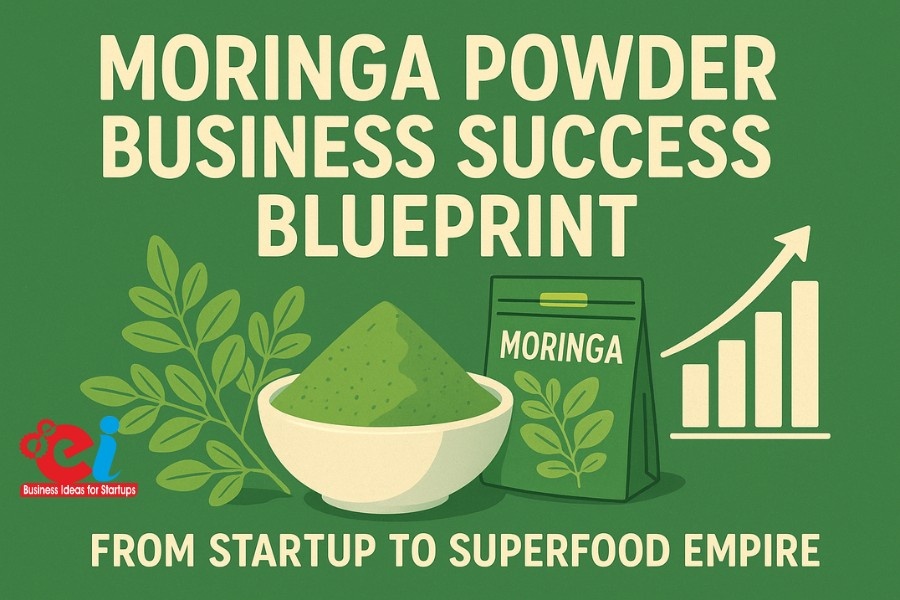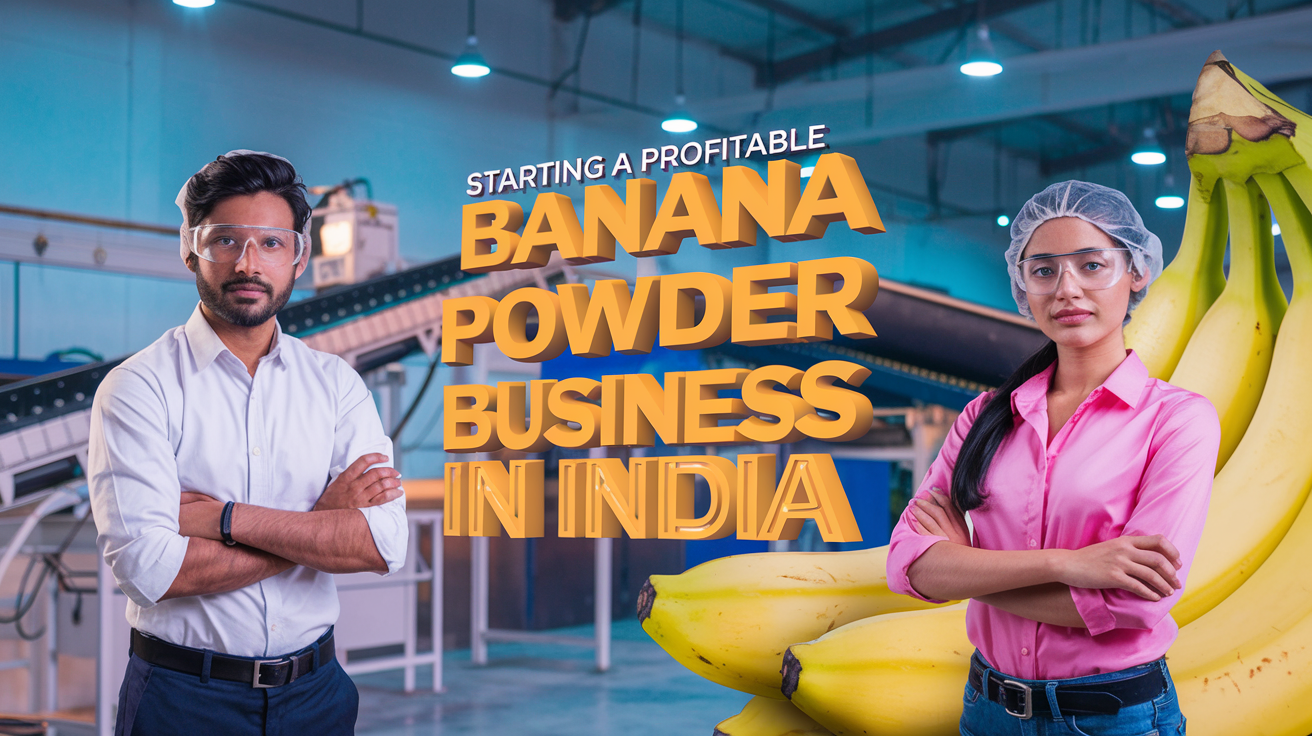Hydroponic farming has gone from science-project cool to the next big thing for entrepreneurs. Pressures like food security worries, cities swelling with new residents, and the push for greener farming are all driving interest in crops grown without soil. With hydroponics, the plants get the nutrients they need in a water solution, which means bigger harvests, crops all year long, and less water and land compared to traditional agriculture. If you’re thinking of launching a startup in this space, the hot topic is: what hydroponic crop will make you the most money?
We’ve rounded up the ten hydroponic crops in high demand both globally and in India. This article breaks down demand data, shares a market forecast, explains how to grow each crop, and shines a spotlight on the firms leading the charge. All the facts come from market research, feasibility reports, and industry sources like Chemical Weekly, so you get the complete picture to see whether this fast-growing market is the right place for your new venture.
Market Outlook for Hydroponic Crops Farming
The worldwide hydroponic crops scene was valued between USD 32 and 35 billion in 2022. Experts expect it to expand at an annual rate of almost 10% from 2023 to 2030, which means it could be worth around USD 65 billion by 2030. City dwellers are pushing the trend, looking for food that is pesticide-free and tastes fresher. Businesses, too—think hotels, restaurants, and even drug firms that use herbs in their meds—are snapping up greens grown without soil.
Hydroponic crops is on the rise across India, moving from niche to mainstream at record speed. In 2022, the sector was worth around USD 70–80 million, yet experts expect it to grow at 12–14% annually over the next five years. Driving this growth are the affluent city demand for farm-fresh vegetables and herbs, alongside the government’s drive to promote controlled-environment farming. Combine this with a wave of private funding, and India is on track to become one of Asia’s fastest-expanding hydroponics markets.
Global Hydroponics Market Forecast
| Year | Market Size (USD Billion) | CAGR (%) |
| 2023 | 38 | 9.8 |
| 2024 | 42 | 9.9 |
| 2025 | 46 | 10.0 |
| 2026 | 51 | 10.2 |
| 2027 | 56 | 10.1 |
| 2028 | 60 | 9.8 |
| 2029 | 63 | 9.7 |
| 2030 | 65 | 9.6 |
| (Source: Industry estimates; Chemical Weekly, 2023 issues) |
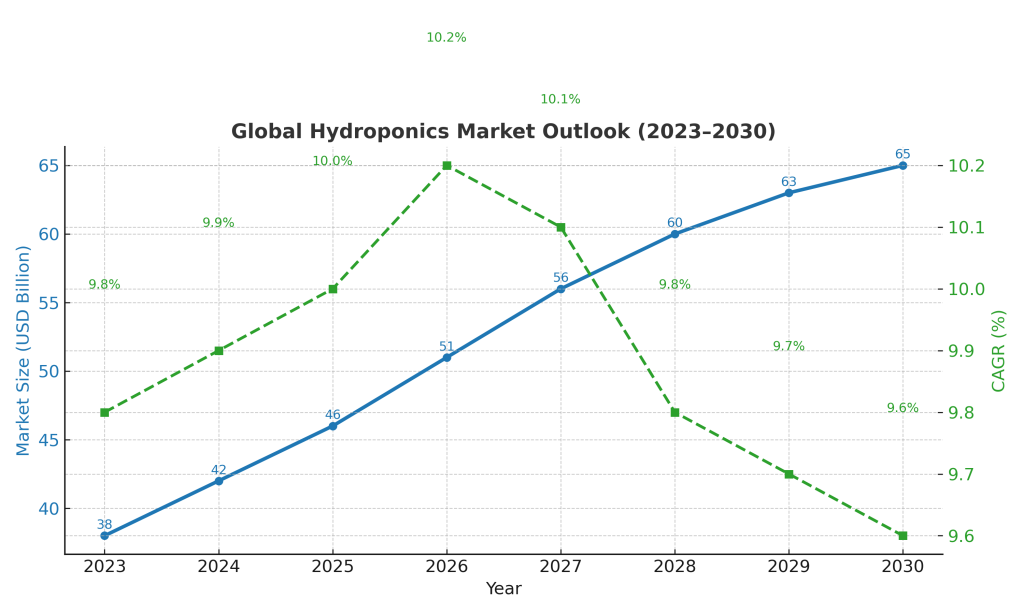
Related: Hydroponic Farming: 7 Remarkable Benefits for a Sustainable Future
Hydroponic Farming at a Glance
Hydroponic crops lets farmers grow plants in a nutrient-packed water solution instead of dirt. Here’s a quick overview of the steps involved:
1. Setting Up the System
Growers decide on a method, such as Nutrient Film Technique (NFT), Deep Water Culture (DWC), aeroponics, or drip, based on the crop type and farm size.
2. Germination
Seeds sprout in inert growth materials like rockwool, cocopeat, or perlite, which provide stability and air.
3. Mixing Nutrient Solution
A precisely balanced cocktail of macros and micros is dissolved in water, then delivered directly to the plants, speeding up growth and maximizing yield.
4. Controlled Environment
In hydroponic systems, we keep the perfect growing conditions all day, every day. LED lights, heating, cooling, and humidity controls work together to keep plants happy, no matter what it’s like outside.
5. Growth and Harvest
Since we skip soil and deliver the right nutrients directly to roots, plants leaf out and fruit faster. Crops can be harvested six to eight weeks from seed, doubling and sometimes tripling the number a typical farmer would plant outside in a year. Hydro systems use as much as 90% less water, small footprints, and deliver big harvests every month.
View Our Books on Herbs Cultivation, Medicinal, Aromatic Plants cultivation, Growing, Plantation
Top 10 Hydroponic Crops with the Highest Market Demand
1. Lettuce
Lettuce tops the hydro list. At 30 to 45 days from seed to salad, it delivers quick and constant cash. Tasty, crunchy leaves end up in salads, wraps, and smoothies, and urban buyers can find it in every supermarket. Demand is growing with a 7% annual bump, and India’s metro areas are leading with salad bars and QSRs。
2. Tomatoes
Tomatoes are second to none in the veggie market, and hydroponic versions make consumers happy with uniform color, tight sizing, and richer taste. In Europe and North America, hybrid varieties ship already color-ready and last much longer, so stores and families waste less. India lovers eat, can, and export tomatoes, so hydro versions sold in metro-premium stores, restaurants, and export routes fit the nation’s tomato appetite.
3. Cucumbers
Cucumbers are everywhere—salads, refreshing juices, even on crunch, tangy pickles. Growing them hydroponically really shines. Plants fill troughs and towers, soaking in nutrients and water, so their fruits come out perfectly straight and totally even in size. Right now, everybody wants cucumbers, especially across the Middle East and Southeast Asia. Supermarkets there are growing their hydroponic programs fast to keep up.
Related: How to Start a Profitable Polyhouse Farming Business
4. Spinach
Spinach and hydroponics are a match made in plant heaven. This leafy green has a speedy life cycle, and lettuce also loves climate control. City folks, gym lovers, and even hospitals are asking for fresh spinach with bright green leaves and the crunch of health. Hydro systems take the lead, giving spinach an extra bump in nutrients and a whole lot less grit. Imagine bags of clean, pesticide-free spinach hitting the fridge the same day they’re harvested.
5. Bell Peppers (Capsicum)
Bell peppers are the diva of the vegetable aisle and they know it. Red, yellow, and green—all perfectly colored and perfectly formed. Hydroponics keeps these beauties on stage 365 days a year, letting green grocers and food processors sell them at a premium. In urban India, the capsaicin is especially hot: capsicum is a favorite for everything from spicy pizza to bright, colorful pasta. Hydroponic systems inside shipping containers are popping up to keep the demand sizzling, no soil or dull harvests needed.
6. Strawberries
Growing strawberries hydroponically ranks among the most rewarding ventures, yet the keys are perfect temperature and nutrient balance. Indian farmers have long grown strawberries in Maharashtra, but with hydroponics, these luscious fruits can now be harvested right next to city rooftops. Experts say the worldwide strawberry market will expand at 6.5% every year until 2030, opening up attractive channels for growers ready to ship berries abroad.
7. Herbs (Basil, Mint, Parsley, Cilantro)
Hydroponic herbs, especially the humble basil, are shooting up in popularity. That’s because food processing, pharmaceuticals, and cosmetics can’t get enough. Year-round yields keep Italian and continental restaurants placing daily orders, so basil lights up profit margins. Plus, these greens are magnetic for Middle Eastern and European buyers looking for freshness, creating yet another export route worth exploring.
8. Kale
Dubbed a “superfood,” hydroponic kale isn’t just a trend; it’s a market with staying power. City dwellers and health buffs snap it up, especially in organic juices and wellness snacks. Startups that tap into this green give customers what they want and unlock a niche that’s thickening at every grocery check-out. Markets are responding, and so are the profits.
9. Microgreens
Microgreens like arugula, mustard, and radish are tiny powerhouses you can crop and sell fast—7 to 10 days max. Michelin chefs and city health nuts are snapping them up, and for small hydroponic farms, they’re golden because they pack big cash per square foot. This quick turnover lets you keep cash flow healthy and space productive, a perfect mix for anyone launching a compact hydro system.
10. Chilies and Exotic Vegetables
If you’re eyeing a higher profit margin, think cherry tomatoes, chilies, and petite zucchini—those eye-catching veggies that look great and sell even better online and in high-end groceries. Hydroponics standardizes supply, so you deliver consistent quality and taste. The reduced risk of soil-borne diseases plus the ability to grow year-round opens the door to premium pricing at home and to global markets.
Global Leaders in Hydroponic Farming
A handful of heavy hitters are designing the future of hydroponic crops farming with tech and massive farms; copy their blueprints and operate smaller, smarter.
| Company Name | Country | Key Focus Area |
| AeroFarms | USA | Aeroponic towers for leafy greens |
| BrightFarms | USA | Neighborhood hydro farms for supermarkets |
| Infarm | Germany | Modular, indoor modules for city restaurants |
| FreshBox Farms | USA | Packaged greens for retail and institutions |
| Spread Co. Ltd. | Japan | Automated, stacked kit farms for leafy greens |
Japan
Automated lettuce farms
Emirates Hydroponics Farm – UAE
Mega hydroponic veggie production
UrbanKisaan – India
Starter-kit urban hydroponics at home
Future Farms – India
Tech backbone for hydroponics farms
These examples show varied ways to make hydroponics work—tiny city farms to huge glass towers. Indian founders can pick, adapt, or mix models to start small or plan big.
Drivers of Growth
Hydroponics is booming because:
- Shoppers care more about health and safe food.
- Cities grow fast, and fields get smaller.
- Policies back eco-friendly farming.
- Export of herbs and fancy veggies looks promising.
- Online groceries now offer top-priced, super-fresh produce.
Startups can win by securing dependable delivery, labelling crops as premium, and targeting microgreens, herbs, or other fancy veggies that pack strong profits.
Role of Feasibility Studies in Hydroponic Business
Before entering the hydroponic farming sector, startups need to carefully evaluate crop selection, system design, and market positioning. Feasibility studies provide essential insights into demand forecasting, raw material requirements, plant layout, and scalability.
At NIIR Project Consultancy Services (NPCS), we prepare Market Survey cum Detailed Techno-Economic Feasibility Reports (DPRs) that include manufacturing processes, raw materials, plant layout, and financials. Our expertise helps entrepreneurs assess the feasibility, profitability, and scalability of setting up new hydroponic farming ventures or allied industries.
Discover the Right Business for You With Our Startup Selector Tool
Conclusion
Hydroponic farming is no longer a niche but a fast-emerging business opportunity for startups across the globe. The top 10 hydroponic crops—lettuce, tomatoes, cucumbers, spinach, bell peppers, strawberries, herbs, kale, microgreens, and chilies/exotics— represent high-demand segments that can ensure profitability when combined with the right technology and market strategy.
With the hydroponics market expected to double by 2030, entrepreneurs entering today stand to benefit from first-mover advantage. By focusing on crops with strong consumer demand and leveraging expert consultancy support such as that from NPCS, startups can position themselves at the forefront of sustainable agriculture and build scalable agribusiness models for the future.
